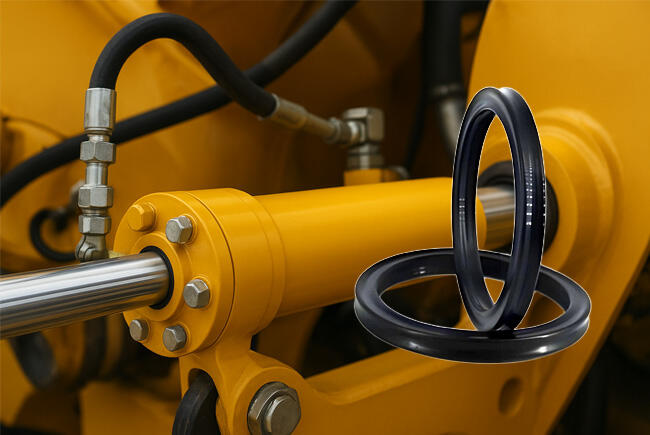There’s a small moment in every hydraulic system where things either stay orderly or begin to drift: first motion, first heat, first uneven contact. An x ring, also called a quad ring, is purpose‑built for those moments. It shares nominal sizes with AS568A O‑rings, drops into the same glands when needed, and in dedicated low‑squeeze grooves it further trims friction. Its X‑shaped profile creates four sealing lips and two micro‑lubrication pockets between them, so films stabilize, start‑up is cleaner, and the seal is less prone to roll in reciprocating motion.
How the profile works
· Pre‑compression plus pressure: Initial squeeze produces radial/axial contact stress; system pressure adds to it, so sealing force scales with load and remains bidirectional in both static and dynamic duties.
· Four lines of defense: The X profile spreads load across four contact lines, lowering the chance of torsional twist and reducing spiral failure compared with round‑section O‑rings.
· Friction under control: Lip cavities retain lubricant; starting friction drops, running friction is more stable, and heat generation is easier to manage.
Operating window and materials
Media and temperature: With compounds such as NBR for oils, FKM for higher temperature and broader media, EPDM for water‑lean chemistries, VMQ for wide temperature windows.
· Pressure and speed: With appropriate clearances and back‑ups, x rings can be engineered for high‑pressure environments up to roughly 40 MPa. As sliding speed rises, pay close attention to lubrication film stability and heat dissipation; in rotary duties, account explicitly for temperature rise from friction.
· Static and dynamic: The profile is at home in reciprocating, oscillating, and low‑speed rotary sealing, while also delivering dependable static sealing on flanges, covers, sleeves, and pipe joints.
Sizing and gland guidance
· Interchangeability with O‑rings: AS568A dimensional parity allows direct substitution in many O‑ring glands, making trials and phased roll‑outs simpler.
· Dynamic preference for thicker sections: In motion, thicker cross‑sections better handle wear, improve compression‑set behavior, and tolerate larger movement gaps; under higher pressure, add back‑up rings and tighten extrusion gaps.
· Rotary allowances and static fits: For rotary shafts, choosing an ID about 2–5% larger than the shaft helps balance running‑in and thermal rise. For static bore interfaces, keep the ring‑to‑gland dimensional deviation within a small window (around 2%) to maintain uniform squeeze without over‑compression.
· Surface and finish: Use compatible lubricants and moderate surface roughness to preserve films, limit wear, and prevent micro‑leak paths at edges.
Why engineers choose x rings over O‑rings in many cases
· Lower friction, cleaner starts: Lubrication pockets and multiple contact lines reduce both running and breakaway friction.
· Less twist in sliding service: The non‑circular section resists rolling in reciprocation, helping prevent premature leak paths.
· Higher efficiency per footprint: Four contact lines provide greater sealing stability within the same gland envelope.
· Extrusion resistance: Distributed load and better hardware support reduce extrusion risk at elevated pressures.
· Versatility: Works in standard O‑ring grooves and in special low‑squeeze glands designed for reduced heat and wear.
Where the x ring series fits best
· Hydraulics and pneumatics: cylinders, actuators, manifolds
· Construction and agriculture: boom/steering cylinders, clamping and tooling
· Energy and wind power: pitch and yaw hydraulic modules
· Pumps and motors: end‑faces and low‑speed shaft positions
· Gearboxes and engines: auxiliary seals and test tooling
· Metallurgy and water treatment: high‑load reciprocating interfaces
· Industrial automation and robotics: joints, clamps, and fixture systems
· Chemical and petrochemical: valve actuators, metering, and test rigs
· Transportation sectors: marine and offshore equipment, rail vehicles, automotive and heavy‑duty trucks (subject to material and compliance validation)

NQKSF Brand, services, and how to engage
· Fast shipment of standard parts: Extensive on‑hand references across O‑rings, oil seals, and related items to meet urgent maintenance or project needs;
· End‑to‑end customization: Material selection, profile/gland design, and production testing tailored to your temperature‑pressure‑media matrix;
· Technical enablement: More than 30 years in sealing practice to help trim wear, manage leakage rates, and raise equipment availability.
Company highlights:
· In‑house manufacturing;
· Deep domain experience in sealing;
· Broad model coverage with ready stock;
· Supply to 80+ countries;
· Collaboration with well‑known global brands;
· Provincial technology innovation center;
· Recognized specialized and innovative enterprise;
· High‑tech enterprise;
· Contributor within a featured industrial cluster.
A practical note to close: when you align geometry, compound, and lubrication—and confirm it with staged pressure and thermal cycling—the x ring series tends to fade into the background of your system. That’s a compliment. Reliable seals don’t ask for attention; they give you uptime, predictable maintenance, and room to focus on the work that matters.
 Hot News
Hot News